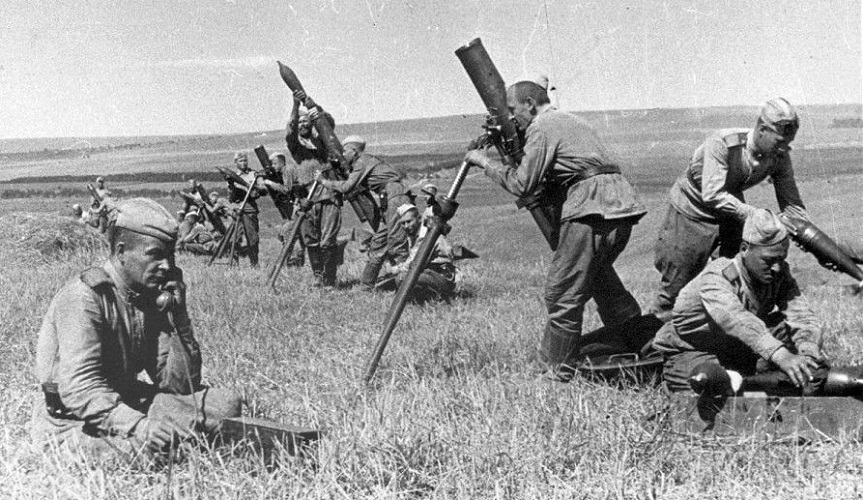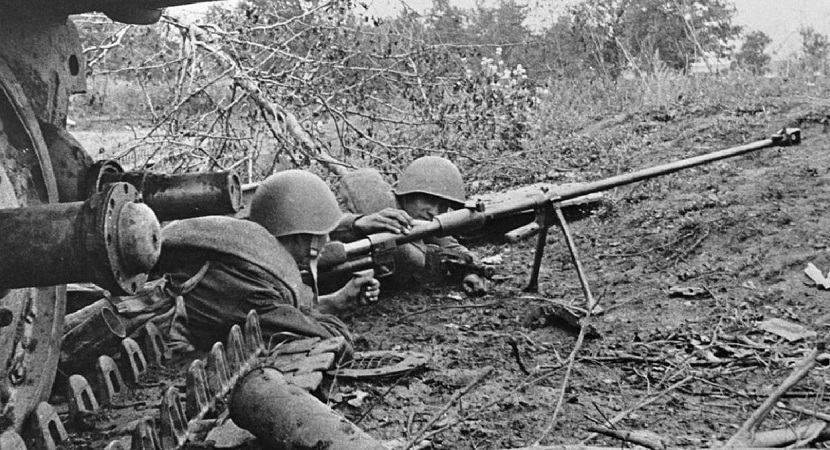● ● ●
The German invasion of the USSR,
commencing on 22 June 1941, brought catastrophe to the Red
Army. Whole divisions, corps, armies were demolished; men in
their millions were killed, wounded and taken prisoner. Only
the great size of the country and its inexhaustible manpower
reserves enabled the regime to stave off disaster. But
though replacements were available in plenty, military
expertise was not. It quickly became clear to Stalin and his
military advisers that a wholesale reorganization of the Red
Army was unavoidably necessary.
In May 1941 Stavka, the high
command, had already promulgated a revision to the table of
organization of the Red Army’s basic unit, the rifle
(infantry) division. The Winter War with Finland had shown
that the 1939
rifle division was too large, and the 5/41
reorganization cut manpower from 18,800 to 14,400. Most of
the specialized units at the division and regimental
level—tank, antiaircraft, engineer, field artillery, signal
battalions—were either eliminated or reduced in size. This
reorganization was in progress at the time of the German
invasion and the disastrous results of the initial battles
compelled Stavka to order another wholesale cut in the
strength of the rifle division in July 1941. Manpower was
reduced to 10,700, mostly by eliminating support troops and
weapons. For example, machine guns were reduced from 490 to
280, 82mm mortars from 54 to 18, 122mm howitzers from 20 to
8, 152mm howitzers from 12 to zero.
In effect the 7/41 rifle division
was just that: a formation armed largely with rifles. From
1941 to 1945, about 50% of a rifle division’s personnel were
actually riflemen, as against about 30% in a German infantry
division. This reflects the former’s greatest deficiency:
the lack of anything in the way of real field artillery. The
weapons themselves were good enough, but thanks to the
severe shortage of technical specialists, such guns and
howitzers as the 7/41 division did possess had mostly to be
employed for direct fire, i.e. fire on targets within visual
range. Primarily for that reason that the staying power of
the 7/41 division was low. With no artillery capable of
long-range
indirect fire, the division had to rely on its
infantry—which inevitably suffered heavy casualties. But at
least such rifle divisions could be raised quickly—an
imperative necessity with the enemy at the gates.

120mm M1938 heavy mortars
in action. By 1943 each rifle regiment had a company with
seven of these powerful but short-ranged weapons (Red Army
photo)
However, the urgent needs of the
front could not be met by the new rifle divisions alone. To
supplement them Stavka also ordered the formation of
independent rifle brigades, which could be set up even more
quickly. Those raised in 1941 and early 1942 mostly had
three rifle battalions and whatever support units could be
scraped up; the diagram accompanying this article depicts an
average 1941 organization. Later they received a fourth
rifle battalion and their table of organization was
formalized. Over 400 rifle brigades were raised during the
war and those not destroyed in combat—as many were—were
mostly upgraded to divisions.
As for the specialist troops that
had been pulled from the rifle divisions at the beginning of
the war, they were consolidated at higher levels of command.
Since there weren’t enough of them to go around the logical
alternative was to create large specialized single-role
units: brigades, divisions, even corps. This happened
especially with the artillery, as is discussed in detail
here.
Four more reorganizations of the
rifle division were ordered between December 1941 and
December 1942, and the last of these was final save for some
minor changes in mid-1944. The 12/42 rifle division had only
9,619 men, but by way of compensation it received a larger
allotment of guns, mortars and, above all, automatic
weapons. In the 7/41 rifle division there had been 162
submachine guns; now there were 2,200. Machine guns were
increased from 280 to 645. The 12/42 rifle division still
had no real artillery, so that the main burden of combat
continued to fall on its infantry. Nor did it have much in
the way of motorized transport, relying mainly on horses to
draw its guns and move its supplies. And by 1943 the
manpower allotted to the rifle divisions was generally of
poor quality: older age groups, sketchily trained or
sometimes even untrained.

Red Army infantry with a
14.5mm PTRD antitank rifle. Every rifle battalion had a
platoon with nine of these weapons ( Red Army photo)
The best men went into the mobile
forces—the tank corps and
mechanized corps—the technical
branches, and into those units awarded the title Guards.
Units of any size and any branch that performed well in
battle could receive this honorific, which carried with it
access to the latest weapons and equipment. Guards rifle
divisions had more men than the standard 12/42 rifle
division: 10,500 versus 9,400. They also had more weapons of
the latest pattern. In 1944, for example, the standard rifle
regiment included one independent company armed entirely
with submachine guns; the Guards rifle regiment had two such
companies. Toward the end of the war Guards rifle divisions
were also authorized a
self-propelled artillery battalion
with SU-76M armored
assault guns, though not all of them received one before the
war ended.
In action against the German Army,
the Red Army’s rifle divisions were destroyed or reduced to
fragments with what would have been regarded in the US and
British armies as depressing regularity. This was due in
part to the standard practice of keeping divisions in the
line until they were destroyed or burned out. At that point,
the remnants would be withdrawn and used either to rebuild
the division with replacements or to help form new
divisions. The relative crudity of Red Army infantry
tactics, particularly on the attack, was another factor.
Close coordination between infantry and artillery, a key
characteristic of German tactics, was not possible for the
Red Army. So unless the preparatory artillery barrage
thoroughly disrupted the German defenses, the first wave of
rifle divisions would suffer crippling casualties in the
breakthrough phase of an attack.
All else being equal, a Red Army
rifle division was no match for a German infantry division,
due primarily to the latter’s far superior artillery. But
during the war more than 700 rifle divisions were raised,
and they served their purpose in the operational technique
that the Red Army evolved over the course of the conflict,
taking it from the banks of the Volga and the suburbs of
Moscow to the center of Berlin.
● ● ●